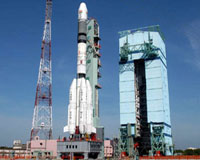 |
New Delhi, India (VOA) Apr 19, 2010 India's ambitious attempt to master a technology needed to launch heavy satellites into space has not succeeded. This could setback the country's hopes of getting a bigger share of the multibillion dollar global satellite launch market. The launch of a rocket using a domestically built cryogenic engine Thursday evening from Sriharikota in southern India was meant to demonstrate India's mastery of a complex technology. Cryogenic engines are rocket motors designed for fuels that have to be held at very low temperatures, and make it possible to launch heavy satellites into space. But disappointed Indian scientists saw the rocket veer off its path after eight minutes and plunge into the Bay of Bengal. The chairman of the Indian Space Research Organization K. Radhakrishnan said the rocket went out of control. "We saw the vehicle was tumbling indicating that controllability was lost...The detailed analysis of the flight data would be carried out," he said. He said that Indian scientists will continue work to perfect the technology within a year. India has spent nearly two decades on developing the cryogenic engine. Only the United States, Russia, France, Japan and China posses the restricted technology. The failure of the flight test using a cryogenic engine will setback India's efforts to grab a larger slice of the multi-billion dollar commercial satellite launch business. The lucrative market is currently controlled by an exclusive club of space-faring nations, including the United States, Russia, China, Ukraine and the European Space Agency. The launch of a small Italian satellite into space in 2007 gave India a foothold in the market. However India's dependence on Russian built cryogenic engines to launch heavy satellites has hampered growth, and prompted Indian scientists to develop the technology. Indian space scientists hope to offer satellite launch services at much cheaper rates compared to Western countries, and expand the business to about $120 million a year. India is an emerging space power and has been designing and building rockets for an ambitious space program.
ISRO Status Report GSLV-D3 vehicle lifted off as planned at 16:27 hrs after a countdown procedure lasting for 29 hours. The countdown went off as planned. GSLV-D3 vehicle performance was normal up to the end of the second stage (GS2) till 293 seconds. Afterwards, the Cryogenic Stage was to ignite and burn for about 720 seconds to provide the necessary velocity to inject GSAT-4 Satellite into the intended Geosynchronous Transfer Orbit. It is yet to be ascertained whether the cryogenic engine did ignite. The vehicle was seen tumbling, lost altitude and finally splashed down in the sea. Detailed analysis of the flight data is being carried out to find out the exact reasons for the failure and take corrective measures to realise the next flight test of the indigenous Cryogenic Engine and Stage within the next one year.
Share This Article With Planet Earth
Related Links ISRO Rocket Science News at Space-Travel.Com
 Indian rocket flops, crashing into sea
Indian rocket flops, crashing into seaBangalore, India (AFP) April 15, 2010 An Indian rocket showcasing domestically built booster technology crashed soon after take-off on Thursday in a blow to the country's space ambitions, officials said. The launch of the first Indian-made cryogenic powered rocket, a complex technology mastered by just five countries, failed soon after lift-off from India's space centre at Sriharikota in the southeastern state of Andhra Pradesh. ... read more |
|
| The content herein, unless otherwise known to be public domain, are Copyright 1995-2010 - SpaceDaily. AFP and UPI Wire Stories are copyright Agence France-Presse and United Press International. ESA Portal Reports are copyright European Space Agency. All NASA sourced material is public domain. Additional copyrights may apply in whole or part to other bona fide parties. Advertising does not imply endorsement,agreement or approval of any opinions, statements or information provided by SpaceDaily on any Web page published or hosted by SpaceDaily. Privacy Statement |